Case Study Analysis: Priorities and Interventions for a Critically Ill Patient
VerifiedAdded on 2023/01/17
|12
|3249
|37
AI Summary
This case study analysis discusses the priorities and interventions for a critically ill patient, focusing on impaired gas exchange and excess fluid volume. It explores the ABCDE framework and evidence-based interventions for improved patient outcomes.
Contribute Materials
Your contribution can guide someone’s learning journey. Share your
documents today.
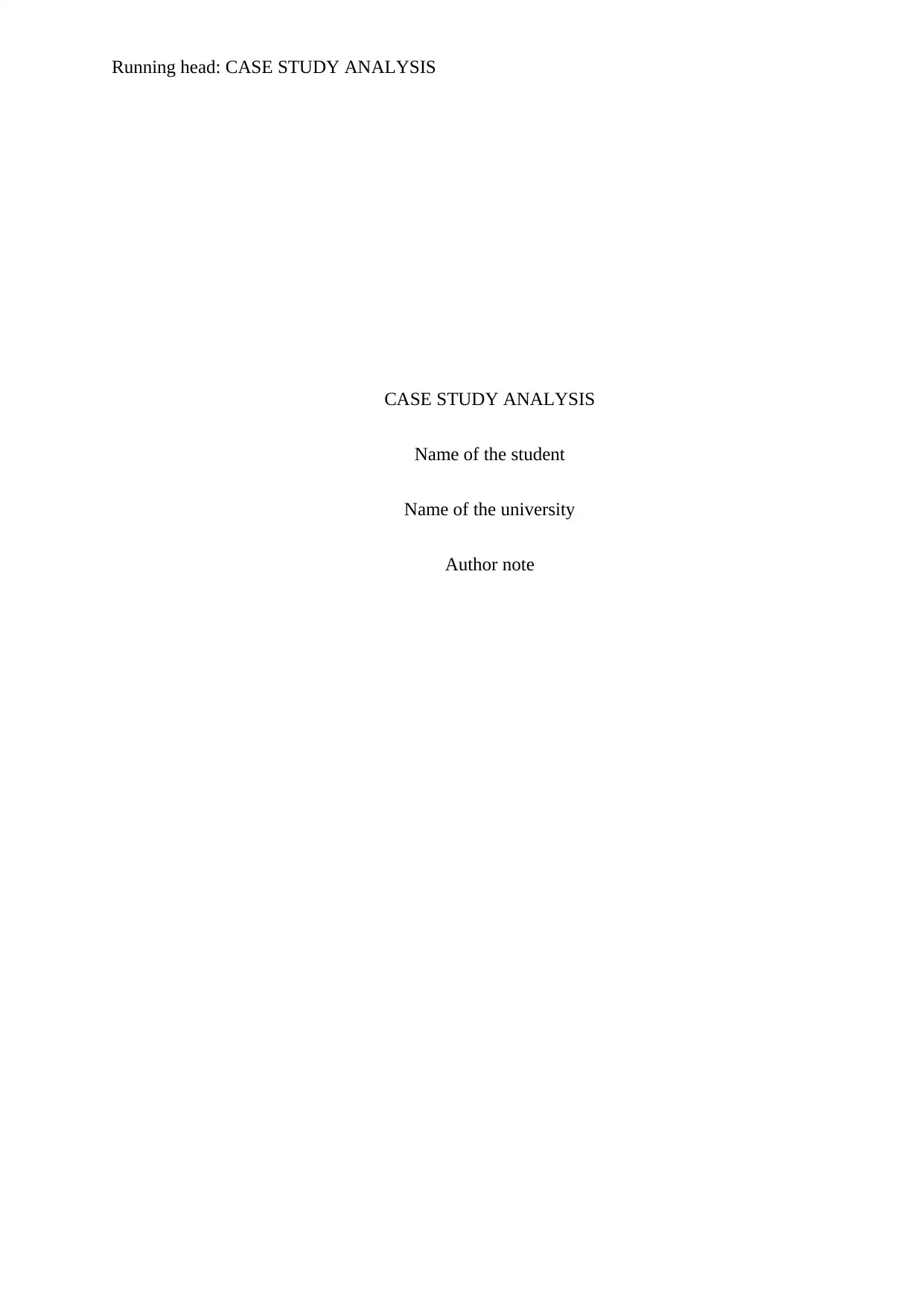
Running head: CASE STUDY ANALYSIS
CASE STUDY ANALYSIS
Name of the student
Name of the university
Author note
CASE STUDY ANALYSIS
Name of the student
Name of the university
Author note
Secure Best Marks with AI Grader
Need help grading? Try our AI Grader for instant feedback on your assignments.

1CASE STUDY ANALYSIS
Introduction
The care process for terminally and critically ill patients are inclusive of influences
from patient’s surroundings, their habits, their past and present health complications and their
mental health conditions that eventually increases and decreases the healthcare complications
(Malbrain et al. 2014). Therefore, to treat such conditions nursing professionals prioritizes the
care process depending on which interventions are applied in the healthcare process and
effectiveness of those interventions brings improved patient outcomes. This paper would
discuss the case study of Mr. Smith, (70), who was admitted to the healthcare facility after
suffering from severe chest pain.
The primary aim of this paper is to implement the ABCDE framework to determine
the two primary priorities for the healthcare condition of the patient and then implement three
different interventions so that those two priorities could be addressed with evidence based
interventions. Finally, a discharge plan for the patient would be developed using the social
justice framework.
Primary priorities
As per Malbrain et al. (2014), application of ABCDE framework should be applied in
the care process for patients suffering from crucial healthcare professionals. This framework
is made up of Airway, Breathing, Circulation, Disability and Exposure. This process is
known as the systematic approach as it helps to conduct an immediate assessment and
identified priorities for the critically or terminally ill patients admitted in the HealthCare
facility (Steyerberg and Vergouwe 2014).
(A)- As per the case study, it was seen that Mr. Smith is suffering from exacerbation
in his chest and is suffering from Chronic Heart Failure. Further, as per his healthcare
observations bibasal coarse crackle, hacking cough and bilateral crackles observed.
Introduction
The care process for terminally and critically ill patients are inclusive of influences
from patient’s surroundings, their habits, their past and present health complications and their
mental health conditions that eventually increases and decreases the healthcare complications
(Malbrain et al. 2014). Therefore, to treat such conditions nursing professionals prioritizes the
care process depending on which interventions are applied in the healthcare process and
effectiveness of those interventions brings improved patient outcomes. This paper would
discuss the case study of Mr. Smith, (70), who was admitted to the healthcare facility after
suffering from severe chest pain.
The primary aim of this paper is to implement the ABCDE framework to determine
the two primary priorities for the healthcare condition of the patient and then implement three
different interventions so that those two priorities could be addressed with evidence based
interventions. Finally, a discharge plan for the patient would be developed using the social
justice framework.
Primary priorities
As per Malbrain et al. (2014), application of ABCDE framework should be applied in
the care process for patients suffering from crucial healthcare professionals. This framework
is made up of Airway, Breathing, Circulation, Disability and Exposure. This process is
known as the systematic approach as it helps to conduct an immediate assessment and
identified priorities for the critically or terminally ill patients admitted in the HealthCare
facility (Steyerberg and Vergouwe 2014).
(A)- As per the case study, it was seen that Mr. Smith is suffering from exacerbation
in his chest and is suffering from Chronic Heart Failure. Further, as per his healthcare
observations bibasal coarse crackle, hacking cough and bilateral crackles observed.
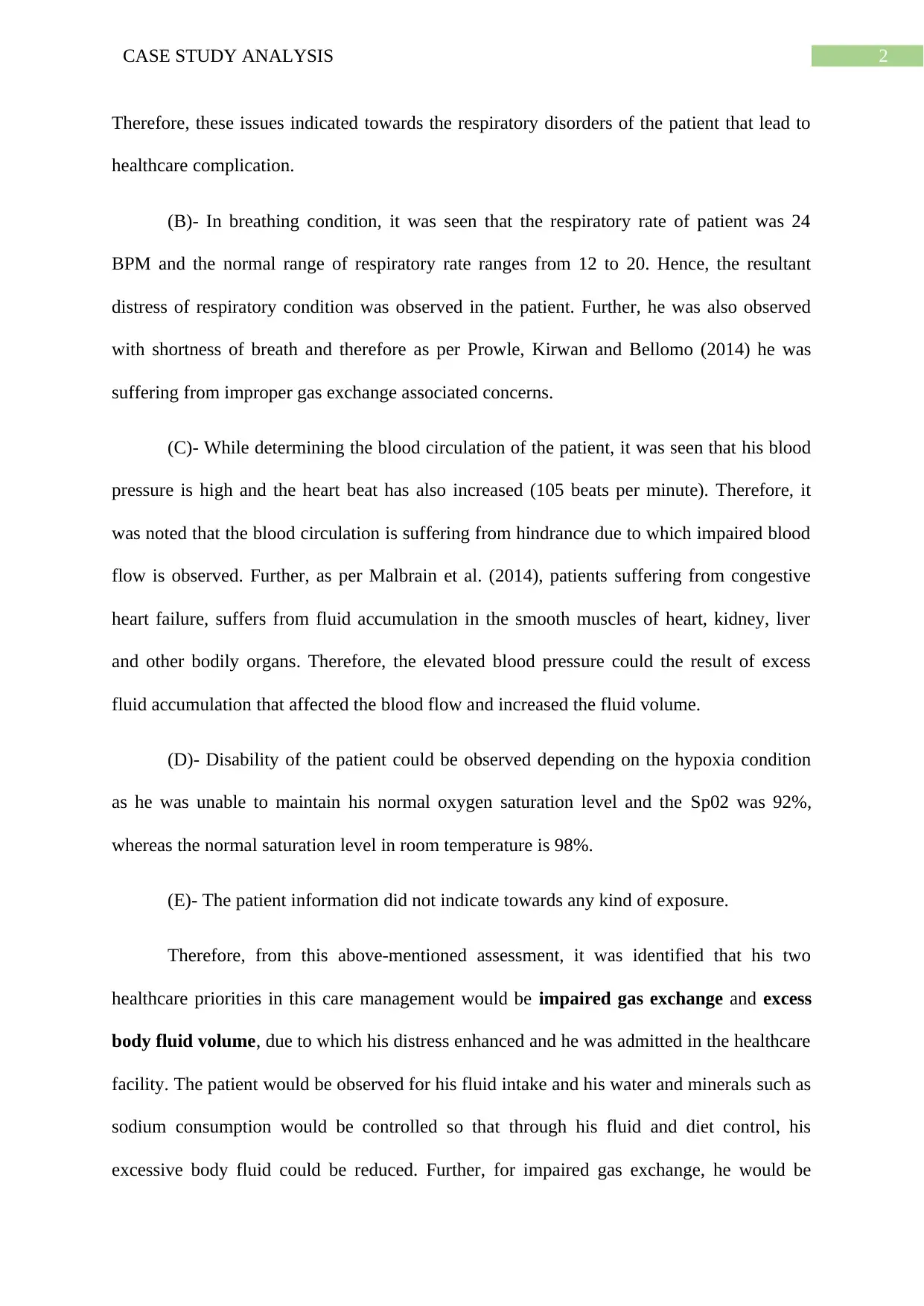
2CASE STUDY ANALYSIS
Therefore, these issues indicated towards the respiratory disorders of the patient that lead to
healthcare complication.
(B)- In breathing condition, it was seen that the respiratory rate of patient was 24
BPM and the normal range of respiratory rate ranges from 12 to 20. Hence, the resultant
distress of respiratory condition was observed in the patient. Further, he was also observed
with shortness of breath and therefore as per Prowle, Kirwan and Bellomo (2014) he was
suffering from improper gas exchange associated concerns.
(C)- While determining the blood circulation of the patient, it was seen that his blood
pressure is high and the heart beat has also increased (105 beats per minute). Therefore, it
was noted that the blood circulation is suffering from hindrance due to which impaired blood
flow is observed. Further, as per Malbrain et al. (2014), patients suffering from congestive
heart failure, suffers from fluid accumulation in the smooth muscles of heart, kidney, liver
and other bodily organs. Therefore, the elevated blood pressure could the result of excess
fluid accumulation that affected the blood flow and increased the fluid volume.
(D)- Disability of the patient could be observed depending on the hypoxia condition
as he was unable to maintain his normal oxygen saturation level and the Sp02 was 92%,
whereas the normal saturation level in room temperature is 98%.
(E)- The patient information did not indicate towards any kind of exposure.
Therefore, from this above-mentioned assessment, it was identified that his two
healthcare priorities in this care management would be impaired gas exchange and excess
body fluid volume, due to which his distress enhanced and he was admitted in the healthcare
facility. The patient would be observed for his fluid intake and his water and minerals such as
sodium consumption would be controlled so that through his fluid and diet control, his
excessive body fluid could be reduced. Further, for impaired gas exchange, he would be
Therefore, these issues indicated towards the respiratory disorders of the patient that lead to
healthcare complication.
(B)- In breathing condition, it was seen that the respiratory rate of patient was 24
BPM and the normal range of respiratory rate ranges from 12 to 20. Hence, the resultant
distress of respiratory condition was observed in the patient. Further, he was also observed
with shortness of breath and therefore as per Prowle, Kirwan and Bellomo (2014) he was
suffering from improper gas exchange associated concerns.
(C)- While determining the blood circulation of the patient, it was seen that his blood
pressure is high and the heart beat has also increased (105 beats per minute). Therefore, it
was noted that the blood circulation is suffering from hindrance due to which impaired blood
flow is observed. Further, as per Malbrain et al. (2014), patients suffering from congestive
heart failure, suffers from fluid accumulation in the smooth muscles of heart, kidney, liver
and other bodily organs. Therefore, the elevated blood pressure could the result of excess
fluid accumulation that affected the blood flow and increased the fluid volume.
(D)- Disability of the patient could be observed depending on the hypoxia condition
as he was unable to maintain his normal oxygen saturation level and the Sp02 was 92%,
whereas the normal saturation level in room temperature is 98%.
(E)- The patient information did not indicate towards any kind of exposure.
Therefore, from this above-mentioned assessment, it was identified that his two
healthcare priorities in this care management would be impaired gas exchange and excess
body fluid volume, due to which his distress enhanced and he was admitted in the healthcare
facility. The patient would be observed for his fluid intake and his water and minerals such as
sodium consumption would be controlled so that through his fluid and diet control, his
excessive body fluid could be reduced. Further, for impaired gas exchange, he would be
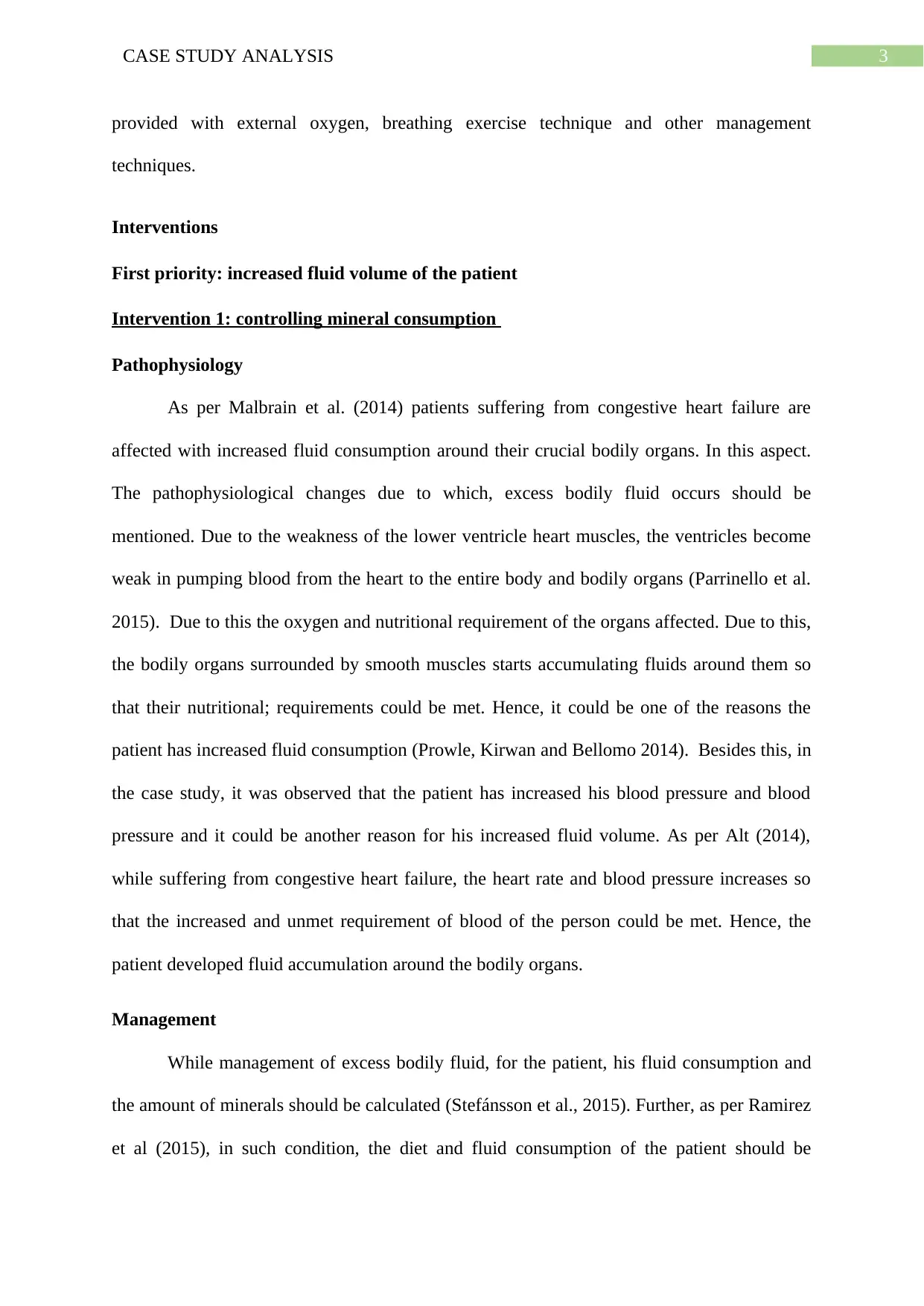
3CASE STUDY ANALYSIS
provided with external oxygen, breathing exercise technique and other management
techniques.
Interventions
First priority: increased fluid volume of the patient
Intervention 1: controlling mineral consumption
Pathophysiology
As per Malbrain et al. (2014) patients suffering from congestive heart failure are
affected with increased fluid consumption around their crucial bodily organs. In this aspect.
The pathophysiological changes due to which, excess bodily fluid occurs should be
mentioned. Due to the weakness of the lower ventricle heart muscles, the ventricles become
weak in pumping blood from the heart to the entire body and bodily organs (Parrinello et al.
2015). Due to this the oxygen and nutritional requirement of the organs affected. Due to this,
the bodily organs surrounded by smooth muscles starts accumulating fluids around them so
that their nutritional; requirements could be met. Hence, it could be one of the reasons the
patient has increased fluid consumption (Prowle, Kirwan and Bellomo 2014). Besides this, in
the case study, it was observed that the patient has increased his blood pressure and blood
pressure and it could be another reason for his increased fluid volume. As per Alt (2014),
while suffering from congestive heart failure, the heart rate and blood pressure increases so
that the increased and unmet requirement of blood of the person could be met. Hence, the
patient developed fluid accumulation around the bodily organs.
Management
While management of excess bodily fluid, for the patient, his fluid consumption and
the amount of minerals should be calculated (Stefánsson et al., 2015). Further, as per Ramirez
et al (2015), in such condition, the diet and fluid consumption of the patient should be
provided with external oxygen, breathing exercise technique and other management
techniques.
Interventions
First priority: increased fluid volume of the patient
Intervention 1: controlling mineral consumption
Pathophysiology
As per Malbrain et al. (2014) patients suffering from congestive heart failure are
affected with increased fluid consumption around their crucial bodily organs. In this aspect.
The pathophysiological changes due to which, excess bodily fluid occurs should be
mentioned. Due to the weakness of the lower ventricle heart muscles, the ventricles become
weak in pumping blood from the heart to the entire body and bodily organs (Parrinello et al.
2015). Due to this the oxygen and nutritional requirement of the organs affected. Due to this,
the bodily organs surrounded by smooth muscles starts accumulating fluids around them so
that their nutritional; requirements could be met. Hence, it could be one of the reasons the
patient has increased fluid consumption (Prowle, Kirwan and Bellomo 2014). Besides this, in
the case study, it was observed that the patient has increased his blood pressure and blood
pressure and it could be another reason for his increased fluid volume. As per Alt (2014),
while suffering from congestive heart failure, the heart rate and blood pressure increases so
that the increased and unmet requirement of blood of the person could be met. Hence, the
patient developed fluid accumulation around the bodily organs.
Management
While management of excess bodily fluid, for the patient, his fluid consumption and
the amount of minerals should be calculated (Stefánsson et al., 2015). Further, as per Ramirez
et al (2015), in such condition, the diet and fluid consumption of the patient should be
Secure Best Marks with AI Grader
Need help grading? Try our AI Grader for instant feedback on your assignments.
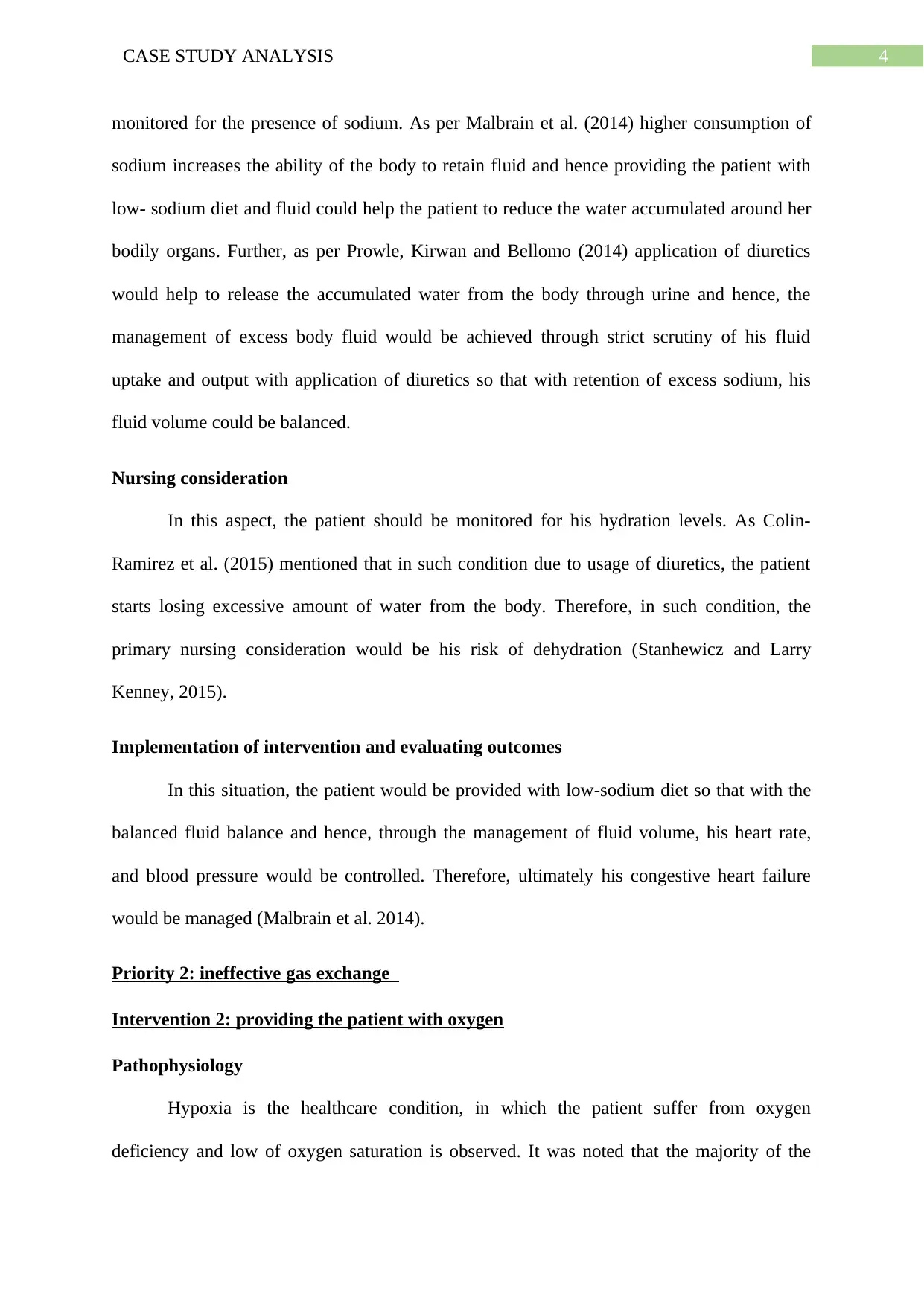
4CASE STUDY ANALYSIS
monitored for the presence of sodium. As per Malbrain et al. (2014) higher consumption of
sodium increases the ability of the body to retain fluid and hence providing the patient with
low- sodium diet and fluid could help the patient to reduce the water accumulated around her
bodily organs. Further, as per Prowle, Kirwan and Bellomo (2014) application of diuretics
would help to release the accumulated water from the body through urine and hence, the
management of excess body fluid would be achieved through strict scrutiny of his fluid
uptake and output with application of diuretics so that with retention of excess sodium, his
fluid volume could be balanced.
Nursing consideration
In this aspect, the patient should be monitored for his hydration levels. As Colin-
Ramirez et al. (2015) mentioned that in such condition due to usage of diuretics, the patient
starts losing excessive amount of water from the body. Therefore, in such condition, the
primary nursing consideration would be his risk of dehydration (Stanhewicz and Larry
Kenney, 2015).
Implementation of intervention and evaluating outcomes
In this situation, the patient would be provided with low-sodium diet so that with the
balanced fluid balance and hence, through the management of fluid volume, his heart rate,
and blood pressure would be controlled. Therefore, ultimately his congestive heart failure
would be managed (Malbrain et al. 2014).
Priority 2: ineffective gas exchange
Intervention 2: providing the patient with oxygen
Pathophysiology
Hypoxia is the healthcare condition, in which the patient suffer from oxygen
deficiency and low of oxygen saturation is observed. It was noted that the majority of the
monitored for the presence of sodium. As per Malbrain et al. (2014) higher consumption of
sodium increases the ability of the body to retain fluid and hence providing the patient with
low- sodium diet and fluid could help the patient to reduce the water accumulated around her
bodily organs. Further, as per Prowle, Kirwan and Bellomo (2014) application of diuretics
would help to release the accumulated water from the body through urine and hence, the
management of excess body fluid would be achieved through strict scrutiny of his fluid
uptake and output with application of diuretics so that with retention of excess sodium, his
fluid volume could be balanced.
Nursing consideration
In this aspect, the patient should be monitored for his hydration levels. As Colin-
Ramirez et al. (2015) mentioned that in such condition due to usage of diuretics, the patient
starts losing excessive amount of water from the body. Therefore, in such condition, the
primary nursing consideration would be his risk of dehydration (Stanhewicz and Larry
Kenney, 2015).
Implementation of intervention and evaluating outcomes
In this situation, the patient would be provided with low-sodium diet so that with the
balanced fluid balance and hence, through the management of fluid volume, his heart rate,
and blood pressure would be controlled. Therefore, ultimately his congestive heart failure
would be managed (Malbrain et al. 2014).
Priority 2: ineffective gas exchange
Intervention 2: providing the patient with oxygen
Pathophysiology
Hypoxia is the healthcare condition, in which the patient suffer from oxygen
deficiency and low of oxygen saturation is observed. It was noted that the majority of the
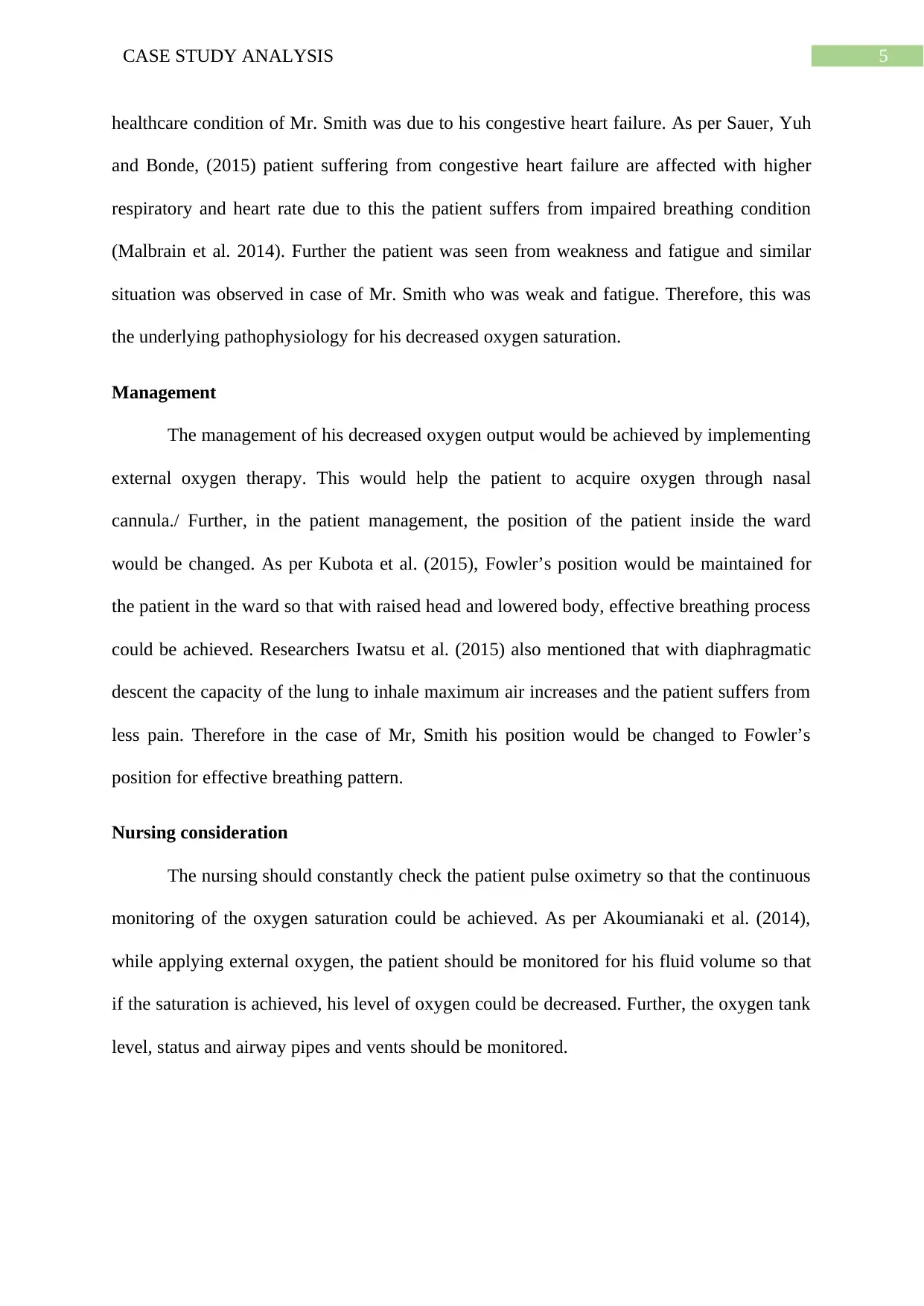
5CASE STUDY ANALYSIS
healthcare condition of Mr. Smith was due to his congestive heart failure. As per Sauer, Yuh
and Bonde, (2015) patient suffering from congestive heart failure are affected with higher
respiratory and heart rate due to this the patient suffers from impaired breathing condition
(Malbrain et al. 2014). Further the patient was seen from weakness and fatigue and similar
situation was observed in case of Mr. Smith who was weak and fatigue. Therefore, this was
the underlying pathophysiology for his decreased oxygen saturation.
Management
The management of his decreased oxygen output would be achieved by implementing
external oxygen therapy. This would help the patient to acquire oxygen through nasal
cannula./ Further, in the patient management, the position of the patient inside the ward
would be changed. As per Kubota et al. (2015), Fowler’s position would be maintained for
the patient in the ward so that with raised head and lowered body, effective breathing process
could be achieved. Researchers Iwatsu et al. (2015) also mentioned that with diaphragmatic
descent the capacity of the lung to inhale maximum air increases and the patient suffers from
less pain. Therefore in the case of Mr, Smith his position would be changed to Fowler’s
position for effective breathing pattern.
Nursing consideration
The nursing should constantly check the patient pulse oximetry so that the continuous
monitoring of the oxygen saturation could be achieved. As per Akoumianaki et al. (2014),
while applying external oxygen, the patient should be monitored for his fluid volume so that
if the saturation is achieved, his level of oxygen could be decreased. Further, the oxygen tank
level, status and airway pipes and vents should be monitored.
healthcare condition of Mr. Smith was due to his congestive heart failure. As per Sauer, Yuh
and Bonde, (2015) patient suffering from congestive heart failure are affected with higher
respiratory and heart rate due to this the patient suffers from impaired breathing condition
(Malbrain et al. 2014). Further the patient was seen from weakness and fatigue and similar
situation was observed in case of Mr. Smith who was weak and fatigue. Therefore, this was
the underlying pathophysiology for his decreased oxygen saturation.
Management
The management of his decreased oxygen output would be achieved by implementing
external oxygen therapy. This would help the patient to acquire oxygen through nasal
cannula./ Further, in the patient management, the position of the patient inside the ward
would be changed. As per Kubota et al. (2015), Fowler’s position would be maintained for
the patient in the ward so that with raised head and lowered body, effective breathing process
could be achieved. Researchers Iwatsu et al. (2015) also mentioned that with diaphragmatic
descent the capacity of the lung to inhale maximum air increases and the patient suffers from
less pain. Therefore in the case of Mr, Smith his position would be changed to Fowler’s
position for effective breathing pattern.
Nursing consideration
The nursing should constantly check the patient pulse oximetry so that the continuous
monitoring of the oxygen saturation could be achieved. As per Akoumianaki et al. (2014),
while applying external oxygen, the patient should be monitored for his fluid volume so that
if the saturation is achieved, his level of oxygen could be decreased. Further, the oxygen tank
level, status and airway pipes and vents should be monitored.
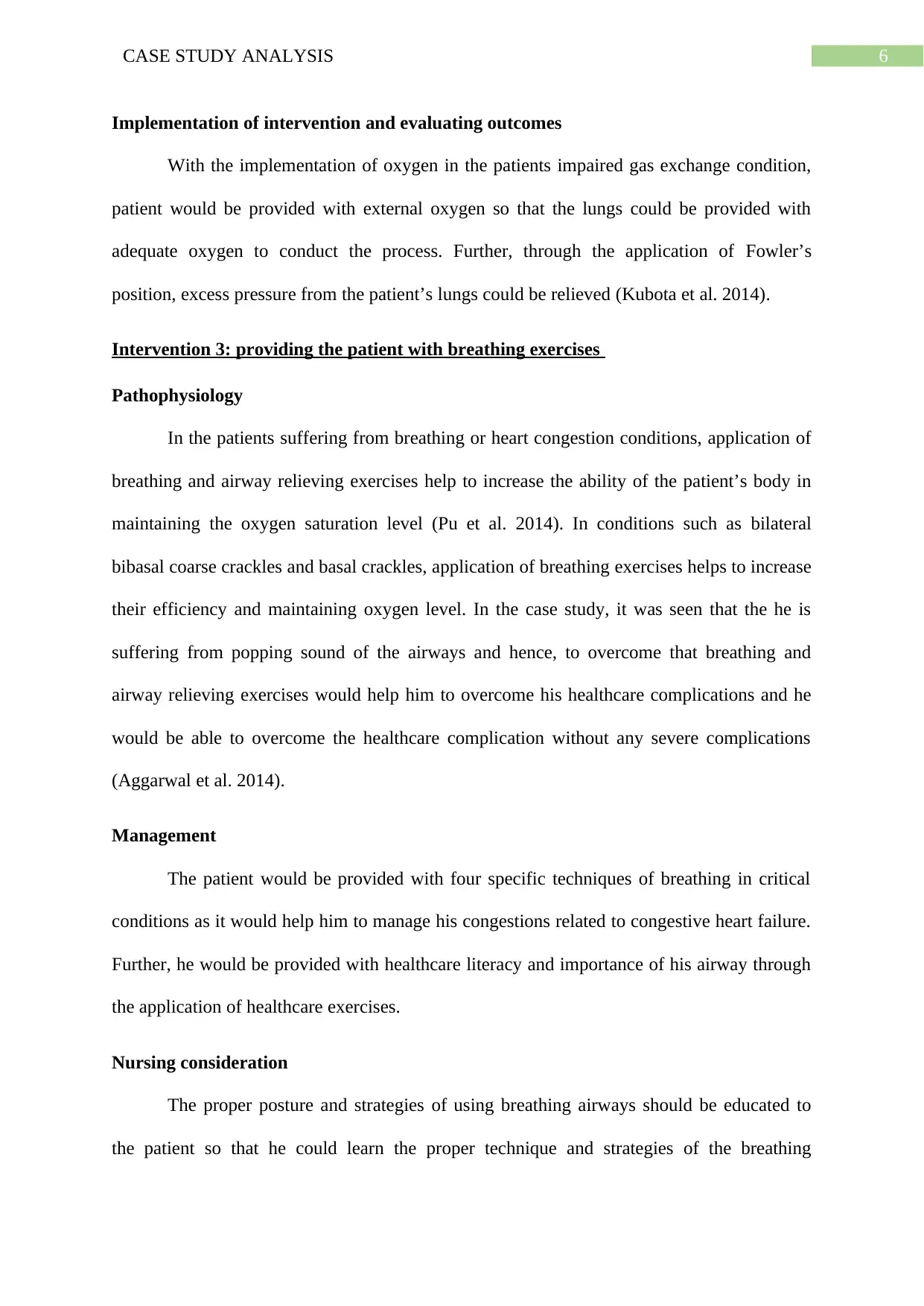
6CASE STUDY ANALYSIS
Implementation of intervention and evaluating outcomes
With the implementation of oxygen in the patients impaired gas exchange condition,
patient would be provided with external oxygen so that the lungs could be provided with
adequate oxygen to conduct the process. Further, through the application of Fowler’s
position, excess pressure from the patient’s lungs could be relieved (Kubota et al. 2014).
Intervention 3: providing the patient with breathing exercises
Pathophysiology
In the patients suffering from breathing or heart congestion conditions, application of
breathing and airway relieving exercises help to increase the ability of the patient’s body in
maintaining the oxygen saturation level (Pu et al. 2014). In conditions such as bilateral
bibasal coarse crackles and basal crackles, application of breathing exercises helps to increase
their efficiency and maintaining oxygen level. In the case study, it was seen that the he is
suffering from popping sound of the airways and hence, to overcome that breathing and
airway relieving exercises would help him to overcome his healthcare complications and he
would be able to overcome the healthcare complication without any severe complications
(Aggarwal et al. 2014).
Management
The patient would be provided with four specific techniques of breathing in critical
conditions as it would help him to manage his congestions related to congestive heart failure.
Further, he would be provided with healthcare literacy and importance of his airway through
the application of healthcare exercises.
Nursing consideration
The proper posture and strategies of using breathing airways should be educated to
the patient so that he could learn the proper technique and strategies of the breathing
Implementation of intervention and evaluating outcomes
With the implementation of oxygen in the patients impaired gas exchange condition,
patient would be provided with external oxygen so that the lungs could be provided with
adequate oxygen to conduct the process. Further, through the application of Fowler’s
position, excess pressure from the patient’s lungs could be relieved (Kubota et al. 2014).
Intervention 3: providing the patient with breathing exercises
Pathophysiology
In the patients suffering from breathing or heart congestion conditions, application of
breathing and airway relieving exercises help to increase the ability of the patient’s body in
maintaining the oxygen saturation level (Pu et al. 2014). In conditions such as bilateral
bibasal coarse crackles and basal crackles, application of breathing exercises helps to increase
their efficiency and maintaining oxygen level. In the case study, it was seen that the he is
suffering from popping sound of the airways and hence, to overcome that breathing and
airway relieving exercises would help him to overcome his healthcare complications and he
would be able to overcome the healthcare complication without any severe complications
(Aggarwal et al. 2014).
Management
The patient would be provided with four specific techniques of breathing in critical
conditions as it would help him to manage his congestions related to congestive heart failure.
Further, he would be provided with healthcare literacy and importance of his airway through
the application of healthcare exercises.
Nursing consideration
The proper posture and strategies of using breathing airways should be educated to
the patient so that he could learn the proper technique and strategies of the breathing
Paraphrase This Document
Need a fresh take? Get an instant paraphrase of this document with our AI Paraphraser
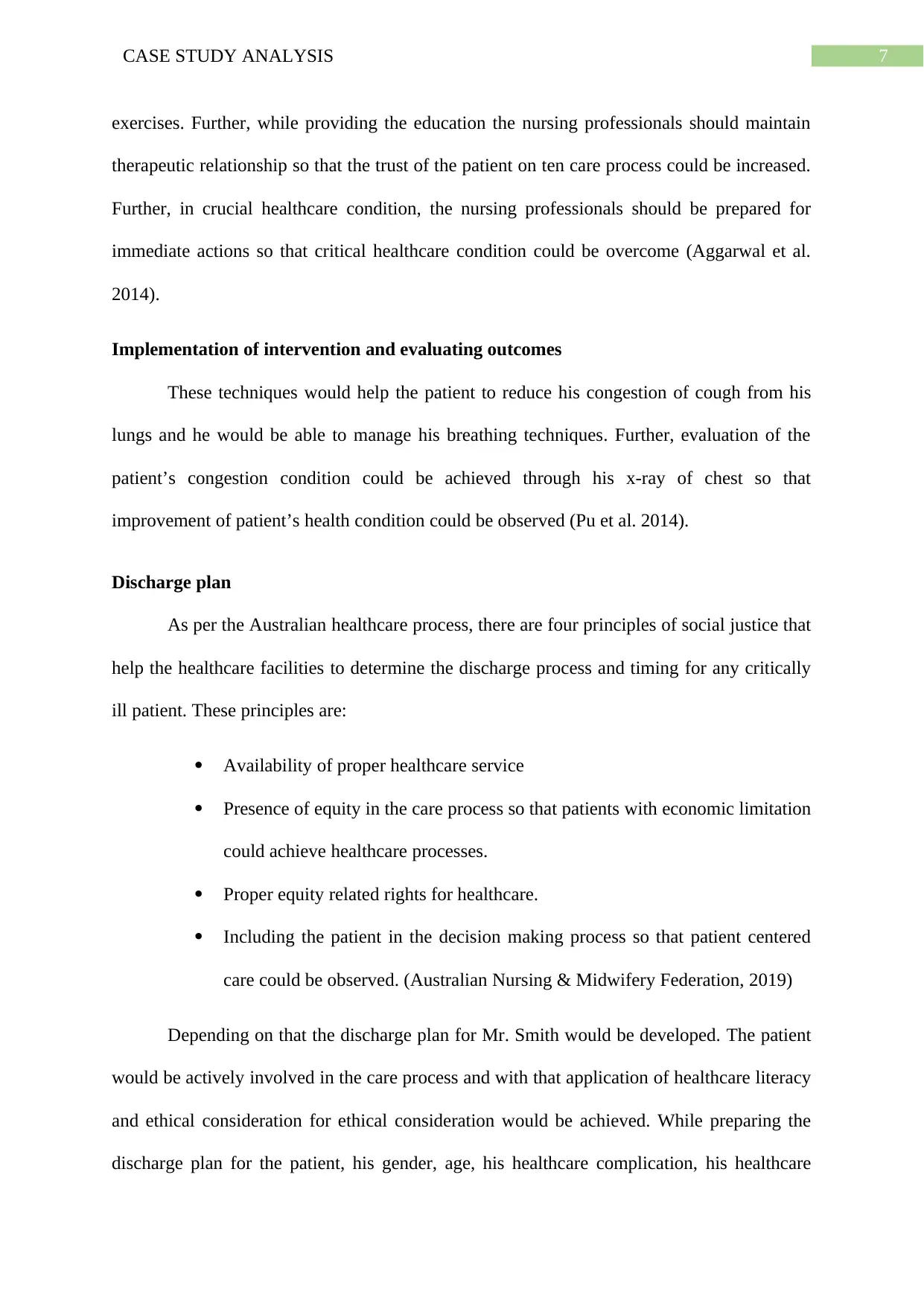
7CASE STUDY ANALYSIS
exercises. Further, while providing the education the nursing professionals should maintain
therapeutic relationship so that the trust of the patient on ten care process could be increased.
Further, in crucial healthcare condition, the nursing professionals should be prepared for
immediate actions so that critical healthcare condition could be overcome (Aggarwal et al.
2014).
Implementation of intervention and evaluating outcomes
These techniques would help the patient to reduce his congestion of cough from his
lungs and he would be able to manage his breathing techniques. Further, evaluation of the
patient’s congestion condition could be achieved through his x-ray of chest so that
improvement of patient’s health condition could be observed (Pu et al. 2014).
Discharge plan
As per the Australian healthcare process, there are four principles of social justice that
help the healthcare facilities to determine the discharge process and timing for any critically
ill patient. These principles are:
Availability of proper healthcare service
Presence of equity in the care process so that patients with economic limitation
could achieve healthcare processes.
Proper equity related rights for healthcare.
Including the patient in the decision making process so that patient centered
care could be observed. (Australian Nursing & Midwifery Federation, 2019)
Depending on that the discharge plan for Mr. Smith would be developed. The patient
would be actively involved in the care process and with that application of healthcare literacy
and ethical consideration for ethical consideration would be achieved. While preparing the
discharge plan for the patient, his gender, age, his healthcare complication, his healthcare
exercises. Further, while providing the education the nursing professionals should maintain
therapeutic relationship so that the trust of the patient on ten care process could be increased.
Further, in crucial healthcare condition, the nursing professionals should be prepared for
immediate actions so that critical healthcare condition could be overcome (Aggarwal et al.
2014).
Implementation of intervention and evaluating outcomes
These techniques would help the patient to reduce his congestion of cough from his
lungs and he would be able to manage his breathing techniques. Further, evaluation of the
patient’s congestion condition could be achieved through his x-ray of chest so that
improvement of patient’s health condition could be observed (Pu et al. 2014).
Discharge plan
As per the Australian healthcare process, there are four principles of social justice that
help the healthcare facilities to determine the discharge process and timing for any critically
ill patient. These principles are:
Availability of proper healthcare service
Presence of equity in the care process so that patients with economic limitation
could achieve healthcare processes.
Proper equity related rights for healthcare.
Including the patient in the decision making process so that patient centered
care could be observed. (Australian Nursing & Midwifery Federation, 2019)
Depending on that the discharge plan for Mr. Smith would be developed. The patient
would be actively involved in the care process and with that application of healthcare literacy
and ethical consideration for ethical consideration would be achieved. While preparing the
discharge plan for the patient, his gender, age, his healthcare complication, his healthcare
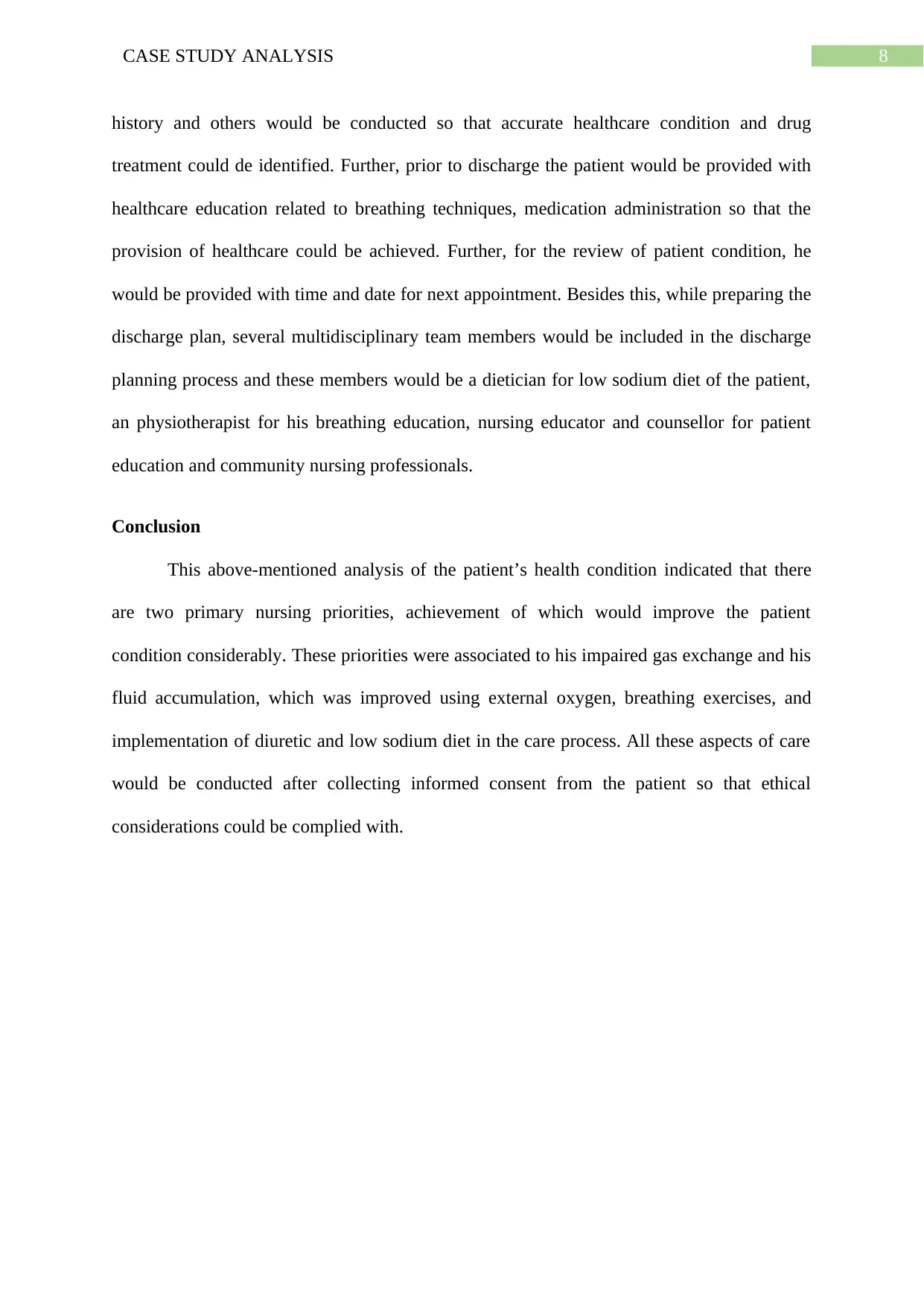
8CASE STUDY ANALYSIS
history and others would be conducted so that accurate healthcare condition and drug
treatment could de identified. Further, prior to discharge the patient would be provided with
healthcare education related to breathing techniques, medication administration so that the
provision of healthcare could be achieved. Further, for the review of patient condition, he
would be provided with time and date for next appointment. Besides this, while preparing the
discharge plan, several multidisciplinary team members would be included in the discharge
planning process and these members would be a dietician for low sodium diet of the patient,
an physiotherapist for his breathing education, nursing educator and counsellor for patient
education and community nursing professionals.
Conclusion
This above-mentioned analysis of the patient’s health condition indicated that there
are two primary nursing priorities, achievement of which would improve the patient
condition considerably. These priorities were associated to his impaired gas exchange and his
fluid accumulation, which was improved using external oxygen, breathing exercises, and
implementation of diuretic and low sodium diet in the care process. All these aspects of care
would be conducted after collecting informed consent from the patient so that ethical
considerations could be complied with.
history and others would be conducted so that accurate healthcare condition and drug
treatment could de identified. Further, prior to discharge the patient would be provided with
healthcare education related to breathing techniques, medication administration so that the
provision of healthcare could be achieved. Further, for the review of patient condition, he
would be provided with time and date for next appointment. Besides this, while preparing the
discharge plan, several multidisciplinary team members would be included in the discharge
planning process and these members would be a dietician for low sodium diet of the patient,
an physiotherapist for his breathing education, nursing educator and counsellor for patient
education and community nursing professionals.
Conclusion
This above-mentioned analysis of the patient’s health condition indicated that there
are two primary nursing priorities, achievement of which would improve the patient
condition considerably. These priorities were associated to his impaired gas exchange and his
fluid accumulation, which was improved using external oxygen, breathing exercises, and
implementation of diuretic and low sodium diet in the care process. All these aspects of care
would be conducted after collecting informed consent from the patient so that ethical
considerations could be complied with.

9CASE STUDY ANALYSIS
References
Aggarwal, S., Nadeem, R., Loomba, R.S., Nida, M. and Vieira, D., 2014. The effects of
continuous positive airways pressure therapy on cardiovascular end points in patients with
sleep‐disordered breathing and heart failure: a meta‐analysis of randomized controlled
trials. Clinical cardiology, 37(1), pp.57-65.
Akoumianaki, E., Maggiore, S.M., Valenza, F., Bellani, G., Jubran, A., Loring, S.H., Pelosi,
P., Talmor, D., Grasso, S., Chiumello, D. and Guérin, C., 2014. The application of
esophageal pressure measurement in patients with respiratory failure. American journal of
respiratory and critical care medicine, 189(5), pp.520-531.
Alt, E., Medtronic Inc, 2014. Congestive heart failure monitor and ventilation measuring
implant. U.S. Patent 8,777,851.
Australian Nursing & Midwifery Federation. 2019. Social Justice. Access date: 3rd April
2019. Retrieved from: http://anmf.org.au/pages/social-justice
Colin-Ramirez, E., McAlister, F.A., Zheng, Y., Sharma, S., Armstrong, P.W. and Ezekowitz,
J.A., 2015. The long-term effects of dietary sodium restriction on clinical outcomes in
patients with heart failure. The SODIUM-HF (Study of Dietary Intervention Under 100 mmol
in Heart Failure): a pilot study. American heart journal, 169(2), pp.274-281.
Iwatsu, K., Yamada, S., Iida, Y., Sampei, H., Kobayashi, K., Kainuma, M. and Usui, A.,
2015. Feasibility of neuromuscular electrical stimulation immediately after cardiovascular
surgery. Archives of physical medicine and rehabilitation, 96(1), pp.63-68.
Kubota, S., Endo, Y., Kubota, M., Ishizuka, Y. and Furudate, T., 2015. Effects of trunk
posture in Fowler's position on hemodynamics. Autonomic Neuroscience, 189, pp.56-59.
References
Aggarwal, S., Nadeem, R., Loomba, R.S., Nida, M. and Vieira, D., 2014. The effects of
continuous positive airways pressure therapy on cardiovascular end points in patients with
sleep‐disordered breathing and heart failure: a meta‐analysis of randomized controlled
trials. Clinical cardiology, 37(1), pp.57-65.
Akoumianaki, E., Maggiore, S.M., Valenza, F., Bellani, G., Jubran, A., Loring, S.H., Pelosi,
P., Talmor, D., Grasso, S., Chiumello, D. and Guérin, C., 2014. The application of
esophageal pressure measurement in patients with respiratory failure. American journal of
respiratory and critical care medicine, 189(5), pp.520-531.
Alt, E., Medtronic Inc, 2014. Congestive heart failure monitor and ventilation measuring
implant. U.S. Patent 8,777,851.
Australian Nursing & Midwifery Federation. 2019. Social Justice. Access date: 3rd April
2019. Retrieved from: http://anmf.org.au/pages/social-justice
Colin-Ramirez, E., McAlister, F.A., Zheng, Y., Sharma, S., Armstrong, P.W. and Ezekowitz,
J.A., 2015. The long-term effects of dietary sodium restriction on clinical outcomes in
patients with heart failure. The SODIUM-HF (Study of Dietary Intervention Under 100 mmol
in Heart Failure): a pilot study. American heart journal, 169(2), pp.274-281.
Iwatsu, K., Yamada, S., Iida, Y., Sampei, H., Kobayashi, K., Kainuma, M. and Usui, A.,
2015. Feasibility of neuromuscular electrical stimulation immediately after cardiovascular
surgery. Archives of physical medicine and rehabilitation, 96(1), pp.63-68.
Kubota, S., Endo, Y., Kubota, M., Ishizuka, Y. and Furudate, T., 2015. Effects of trunk
posture in Fowler's position on hemodynamics. Autonomic Neuroscience, 189, pp.56-59.
Secure Best Marks with AI Grader
Need help grading? Try our AI Grader for instant feedback on your assignments.
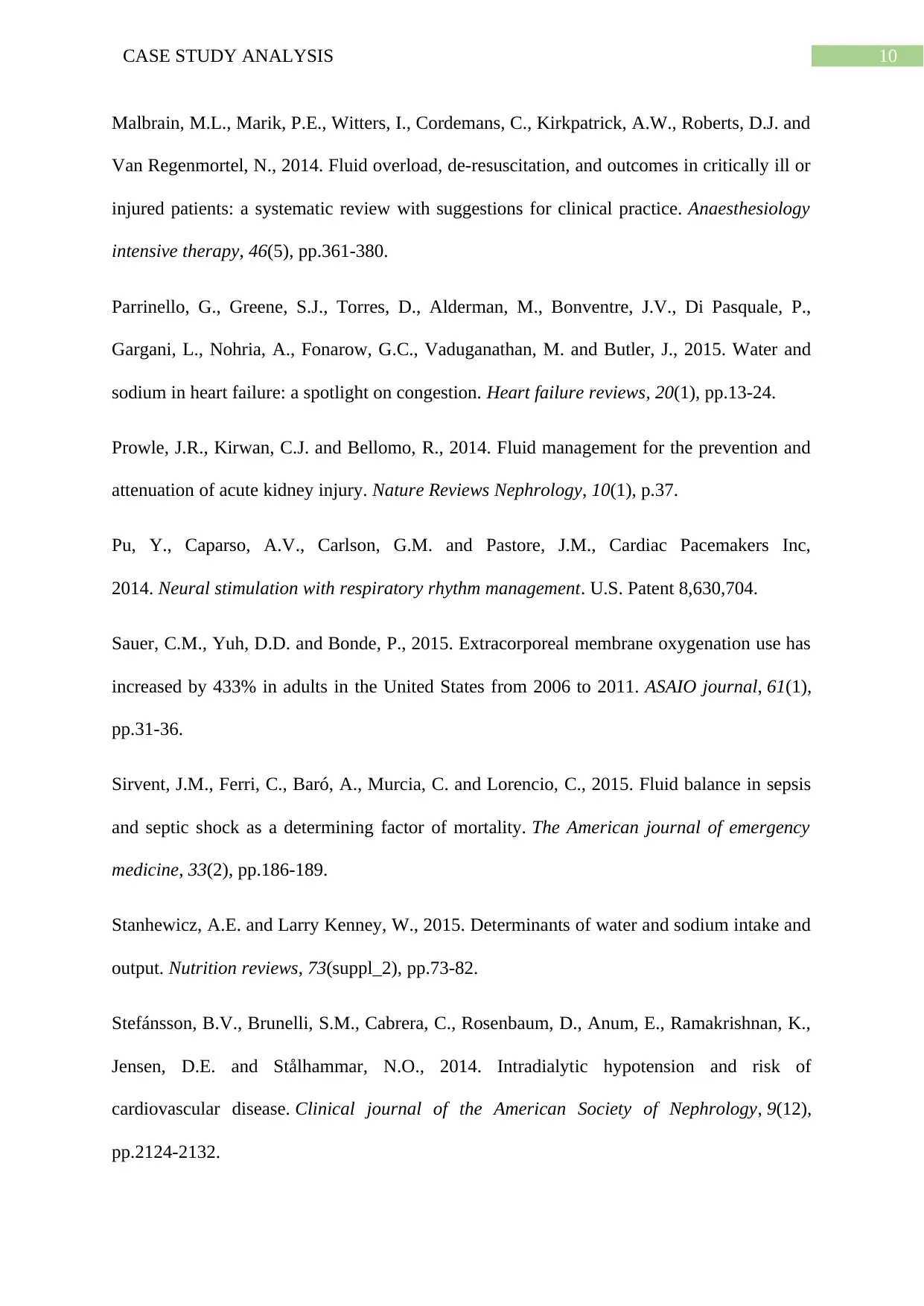
10CASE STUDY ANALYSIS
Malbrain, M.L., Marik, P.E., Witters, I., Cordemans, C., Kirkpatrick, A.W., Roberts, D.J. and
Van Regenmortel, N., 2014. Fluid overload, de-resuscitation, and outcomes in critically ill or
injured patients: a systematic review with suggestions for clinical practice. Anaesthesiology
intensive therapy, 46(5), pp.361-380.
Parrinello, G., Greene, S.J., Torres, D., Alderman, M., Bonventre, J.V., Di Pasquale, P.,
Gargani, L., Nohria, A., Fonarow, G.C., Vaduganathan, M. and Butler, J., 2015. Water and
sodium in heart failure: a spotlight on congestion. Heart failure reviews, 20(1), pp.13-24.
Prowle, J.R., Kirwan, C.J. and Bellomo, R., 2014. Fluid management for the prevention and
attenuation of acute kidney injury. Nature Reviews Nephrology, 10(1), p.37.
Pu, Y., Caparso, A.V., Carlson, G.M. and Pastore, J.M., Cardiac Pacemakers Inc,
2014. Neural stimulation with respiratory rhythm management. U.S. Patent 8,630,704.
Sauer, C.M., Yuh, D.D. and Bonde, P., 2015. Extracorporeal membrane oxygenation use has
increased by 433% in adults in the United States from 2006 to 2011. ASAIO journal, 61(1),
pp.31-36.
Sirvent, J.M., Ferri, C., Baró, A., Murcia, C. and Lorencio, C., 2015. Fluid balance in sepsis
and septic shock as a determining factor of mortality. The American journal of emergency
medicine, 33(2), pp.186-189.
Stanhewicz, A.E. and Larry Kenney, W., 2015. Determinants of water and sodium intake and
output. Nutrition reviews, 73(suppl_2), pp.73-82.
Stefánsson, B.V., Brunelli, S.M., Cabrera, C., Rosenbaum, D., Anum, E., Ramakrishnan, K.,
Jensen, D.E. and Stålhammar, N.O., 2014. Intradialytic hypotension and risk of
cardiovascular disease. Clinical journal of the American Society of Nephrology, 9(12),
pp.2124-2132.
Malbrain, M.L., Marik, P.E., Witters, I., Cordemans, C., Kirkpatrick, A.W., Roberts, D.J. and
Van Regenmortel, N., 2014. Fluid overload, de-resuscitation, and outcomes in critically ill or
injured patients: a systematic review with suggestions for clinical practice. Anaesthesiology
intensive therapy, 46(5), pp.361-380.
Parrinello, G., Greene, S.J., Torres, D., Alderman, M., Bonventre, J.V., Di Pasquale, P.,
Gargani, L., Nohria, A., Fonarow, G.C., Vaduganathan, M. and Butler, J., 2015. Water and
sodium in heart failure: a spotlight on congestion. Heart failure reviews, 20(1), pp.13-24.
Prowle, J.R., Kirwan, C.J. and Bellomo, R., 2014. Fluid management for the prevention and
attenuation of acute kidney injury. Nature Reviews Nephrology, 10(1), p.37.
Pu, Y., Caparso, A.V., Carlson, G.M. and Pastore, J.M., Cardiac Pacemakers Inc,
2014. Neural stimulation with respiratory rhythm management. U.S. Patent 8,630,704.
Sauer, C.M., Yuh, D.D. and Bonde, P., 2015. Extracorporeal membrane oxygenation use has
increased by 433% in adults in the United States from 2006 to 2011. ASAIO journal, 61(1),
pp.31-36.
Sirvent, J.M., Ferri, C., Baró, A., Murcia, C. and Lorencio, C., 2015. Fluid balance in sepsis
and septic shock as a determining factor of mortality. The American journal of emergency
medicine, 33(2), pp.186-189.
Stanhewicz, A.E. and Larry Kenney, W., 2015. Determinants of water and sodium intake and
output. Nutrition reviews, 73(suppl_2), pp.73-82.
Stefánsson, B.V., Brunelli, S.M., Cabrera, C., Rosenbaum, D., Anum, E., Ramakrishnan, K.,
Jensen, D.E. and Stålhammar, N.O., 2014. Intradialytic hypotension and risk of
cardiovascular disease. Clinical journal of the American Society of Nephrology, 9(12),
pp.2124-2132.

11CASE STUDY ANALYSIS
Steyerberg, E.W. and Vergouwe, Y., 2014. Towards better clinical prediction models: seven
steps for development and an ABCD for validation. European heart journal, 35(29),
pp.1925-1931.
Steyerberg, E.W. and Vergouwe, Y., 2014. Towards better clinical prediction models: seven
steps for development and an ABCD for validation. European heart journal, 35(29),
pp.1925-1931.
1 out of 12
Related Documents
Your All-in-One AI-Powered Toolkit for Academic Success.
+13062052269
info@desklib.com
Available 24*7 on WhatsApp / Email
![[object Object]](/_next/static/media/star-bottom.7253800d.svg)
Unlock your academic potential
© 2024 | Zucol Services PVT LTD | All rights reserved.




